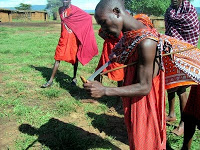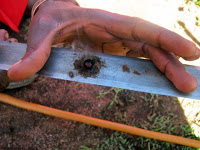One of our most intriguing findings, in visiting the Maasai and getting to know them through Tomas, is just how little they depend on things that are purchased. They do all their own medicine, as we all know, and hearing Tomas describe some of the ways they use herbs and leaves and bark and such is an amazing learning experience. And one that puts the modern Westerner a little in awe of the abilities that these people have, all crafts and skills passed down from generation to generation.
And quite naturally giving us pause when we think about how with our modern knowledge management techniques we presume we can help contribute to this particular type of knowledge sharing. I’m not so sure we can. We’re very good at capturing and sharing knowledge about what we’ve been dealing with ourselves, as a culture for some centuries. But can we capture and manage what these people know? Perhaps Prusak and Davenport are right: you can’t manage knowledge – certainly not this kind of knowledge – but you can work with knowledge, their definition of knowledge management.
As we arrived at the manyatta, even before Tomas had explained to me about the wooden stickfence, he pulled off a few leaves from a shrub and handed it to me.
“Sandpaper,” he said.
I was a little confused, but it soon became clear to me how important this particular bush is. Its leaf does indeed feel like a sheet of medium-to-fine sandpaper. As we visited the manyatta, he pointed out to me quite a few situations in which the sandpaper leaf is used to make the wood smooth, the most obvious being the beautiful wooden sticks every Maasai man uses and walks with.
Young or old, boy or man, it doesn’t matter. No Maasai man walks along without his stick, and they are beautifully rubbed to be as smooth as they can be.
The most spectacular use of the sandpaper leaf has to be in preparing the sticks for making fire. We all heard about this when we were in the Boy Scouts, but I’m not sure any of it ever made sense, or even caught on. But these guys have it down to a fine art. They don’t bother with matches. It’s pure elbow (or hand-rubbing) grease. The trick is to gauge out a little hole in one stick, and then you trim a long smooth stick, specially chosen and carefully cut to match the hold, and the spin the long stick round and round as fast as you can, using the flat of your hands held together. It’s hard work, and often three or four or more men will be used to get it going but, as you can see in Mr. Guy’s Masai Mara (6) Album, you do soon start to smell smoke and pretty soon a little puff of smoke drifts up and then there’s more and lo and behold! There’s your little red coal which you can then use with the tender twigs to get a bigger fire going. Amazing.


Leave a Reply